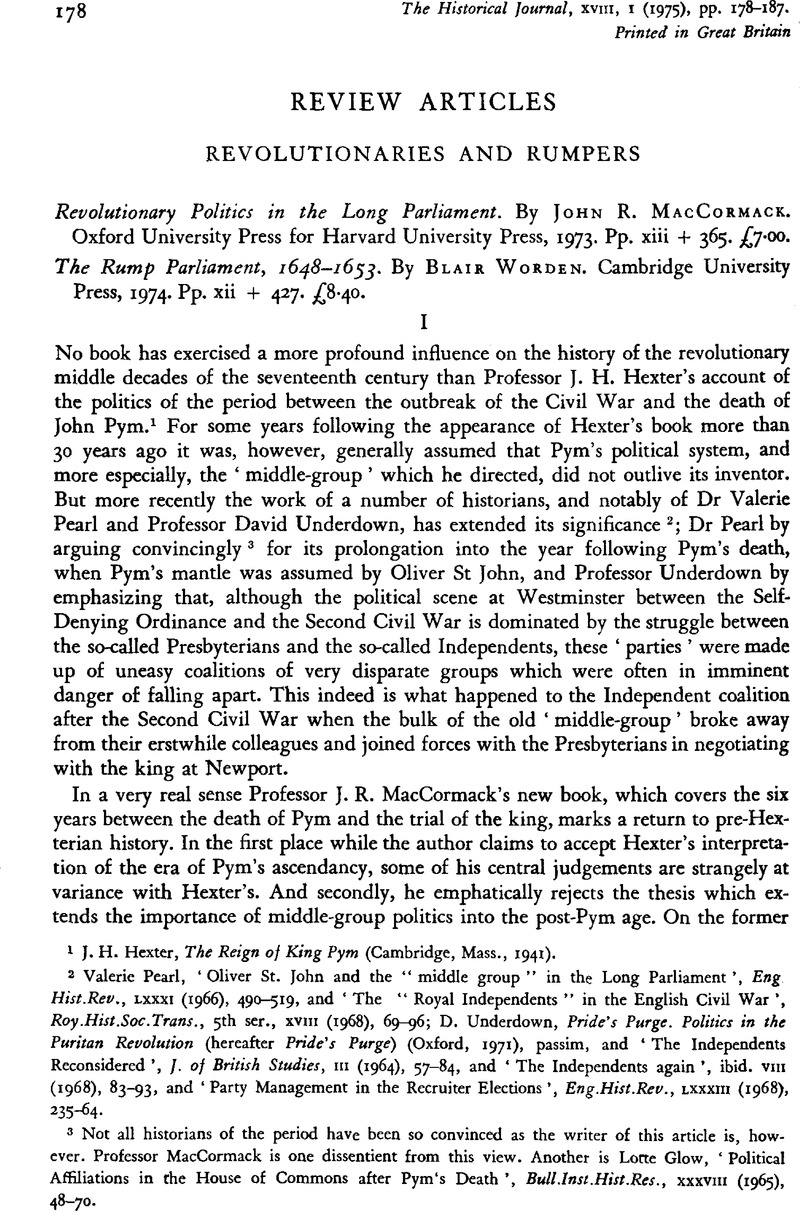Article contents
Revolutionaries and Rumpers
Published online by Cambridge University Press: 11 February 2009
Abstract

- Type
- Review Articles
- Information
- Copyright
- Copyright © Cambridge University Press 1975
References
1 Hexter, J. H., The Reign of King Pym (Cambridge, Mass., 1941).Google Scholar
2 Pearl, Valerie, ‘Oliver St. John and the “middle group” in the Long Parliament’, Eng. Hist.Rev., LXXXI (1966), 490–519CrossRefGoogle Scholar, and ‘The “Royal Independents” in the English Civil War’, Roy.Hist.Soc.Trans., 5th ser., xviii (1968), 69–Google Scholar; Underdown, D., Pride's Purge. Politics in the Puritan Revolution (hereafter Pride's Purge) (Oxford, 1971)Google Scholar, passim, and ‘The Independents Reconsidered’, J. of British Studies, III (1964), 57–84Google Scholar, and ‘The Independents again’, ibid, viii (1968), 83–93, and ‘Party Management in the Recruiter Elections’, Eng.Hist.Rev., LXXXIII (1968), 235–64Google Scholar
3 Not all historians of the period have been so convinced as the writer of this article is, however. Professor MacCormack is one dissentient from this view. Another is Glow, Lotte, ‘Political Affiliations in the House of Commons after Pym's Death’, Bull.Inst.Hist.Res., xxxviii (1965), 48–70.CrossRefGoogle Scholar
4 MacCormack, , op. cit. p. 1.Google Scholar
5 Harleian Miscellany, v, 216–7.
6 See, for example, A Declaration of the Lords and Commons … in answer to His Majesties Declaration (1642) [Wing 1442], espec. pp. 9–10.
7 MacCormack, , op. cit. p. 307.Google Scholar
8 Ibid. p. 6 and note.
9 Some M.P.s whom it is now customary to consider as middle-groupers are, in fact, assigned to the core rather than the fringes of the two parties. Of the six ‘royal independents’ whose careers as members of the successor to Pym's middle-group have been analysed by Dr Pearl (Roy Hist.Soc.Trans., loc. cit.), five are classified by Professor MacCormack as ‘Core Radicals’, and the other (Pierrepont) converted from the fringe to the core before the end of the year.
10 MacCormack, , op. cit. p. 43.Google Scholar
11 Worden, B., The Rump Parliament, p. 5.Google Scholar
12 Maseres, F. (ed.), Select Tracts relating to the Civil Wars in England in the Reign of King Charles the First (1815), 1, 228–32.Google Scholar
13 MacCormack, , op. cit. pp. 161–2.Google Scholar
14 Ibid. p. 236.
15 Woodhouse, A. S. P. (ed.), Puritanism and Liberty (1938), pp. 106–7.Google Scholar
16 Sexby's analogy, ibid. p. 103.
17 MacCormack, , op. cit. p. 286.Google Scholar
18 ‘The outcome was certainly far from inevitable.’ (Underdown, Pride's Purge, p. 107).
19 Ibid. pp. 128–42, 148–50.
20 MacCormack, , op. cit. p. 294.Google Scholar
21 Ibid. pp. 300–1.
22 Ibid. p. 299.
23 Underdown, , Pride's Purge, pp. 140–1.Google Scholar
24 The evidence for this is carefully summed up in ibid. pp. 164–72.
25 Bodleian, Clarendon MS 34, fos. 17–18 (b).
26 Underdown, , Pride's Purge, espec. pp. 208–96.Google Scholar
27 Milton, John, Works (New York 1932) VII, 29.Google Scholar
28 Worden, , op. cit. p. 384.Google Scholar
29 Underdown, , Pride's Purge, pp. 336–7.Google Scholar
30 Worden, , op. cit. p. 139.Google Scholar
31 Ibid. p. 188.
32 B. Whitelock, Memorials of the Englirh Affairs … (1684), pp. 380–0 (b).
33 Worden, , op. cit. pp. 48–53.Google Scholar
34 Ibid. p. 377.
- 1
- Cited by


